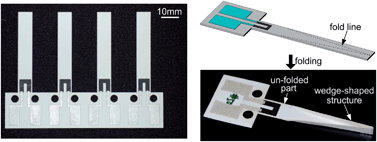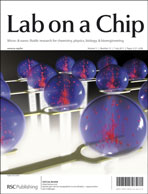Paper-based piezoresistive MEMS sensors†
Abstract
This paper describes the development of MEMS force sensors constructed using paper as the structural material. The working principle on which these paper-based sensors are based is the piezoresistive effect generated by conductive materials patterned on a paper substrate. The device is inexpensive (∼$0.04 per device for materials), simple to fabricate, lightweight, and disposable. Paper can be readily folded into three-dimensional structures to increase the stiffness of the sensor while keeping it light in weight. The entire fabrication process can be completed within one hour without expensive cleanroom facilities using simple tools (e.g., a paper cutter and a painting knife). We demonstrated that the paper-based sensor can measure forces with moderate performance (i.e., resolution: 120 μN, measurement range: ±16 mN, and sensitivity: 0.84 mV mN−1). We applied this sensor to characterizing the mechanical properties of a soft material. Leveraging the same sensing concept, we also developed a paper-based balance with a measurement range of 15 g, and a resolution of 0.39 g.


 Please wait while we load your content...
Please wait while we load your content...